Turkey’s prettiest village? Population: 3,000
Market day: Monday
Old name: Prygium (Roman)
The most beautiful Ottoman house open to the public has to be in Safranbolu, right?
Wrong. In fact it’s in the tiny, out-of-the-way village of Birgi, a couple of hours’ inland from Kuşadası, Selçuk and Ephesus, where a wealthy local potentate Şerif Aliağa built his dream home in 1761.
In the shadow of Bozdağ, Birgi is an extraordinary place, largely ignored by international tourism even though it has a picture-postcard high street of lovely old houses, a fascinating 14th-century mosque and a shrine that attracts thousands of pilgrims every year. Under the guidance of ÇEKUL (www.cekulvakfi.org.tr), it has also become a rare model for sensitive restoration, with signs and souvenir stalls made from wood and street names inscribed on brown backgrounds.
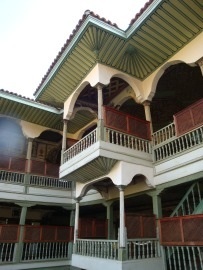 But it is the glorious Çakırağa Konağı that is the real drawcard. At first sight this amazing three-storey building is uncannily reminiscent of the restored Shakespeare Globe Theatre on the bank of the Thames in London. Whereas most Ottoman houses are enclosed, private places that offer no hint of what might be inside them, this konak is the exact opposite, consisting as it does of three floors of open-fronted corridors with rooms opening off them to the rear. The effect is to make the house look like a tiered stage – you half expect someone to rush over and swish the curtains across at the end of your visit.
But it is the glorious Çakırağa Konağı that is the real drawcard. At first sight this amazing three-storey building is uncannily reminiscent of the restored Shakespeare Globe Theatre on the bank of the Thames in London. Whereas most Ottoman houses are enclosed, private places that offer no hint of what might be inside them, this konak is the exact opposite, consisting as it does of three floors of open-fronted corridors with rooms opening off them to the rear. The effect is to make the house look like a tiered stage – you half expect someone to rush over and swish the curtains across at the end of your visit.
What do we know about the man behind the house? Well, Şerif Aliağa was a merchant and a local bigwig (or derebey) who ran the show in late 18th-century Birgi. Aliağa married twice, once to a woman from İstanbul and once to one from İzmir. To save them from feeling homesick in their back-of-beyond new home, Aliağa supposedly commissioned pictures of their hometowns to grace the walls of the top-floor lounges. It’s a pretty story. Unfortunately the presence in the paintings of buildings like the Sarıkışla (Yellow Barracks) in İzmir suggest that they were actually painted after 1826.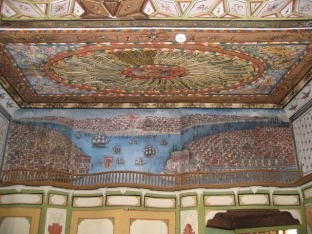
Like most Turkish houses that are open to the public, the Çakırağa Konaği is basically unfurnished, although its walls are pierced with endless niches and built-in cupboards. Most rooms boast gorgeous fireplaces, usually painted with a design of stylised olives. The house reopened to the public after extensive restoration in 2023.
Around town
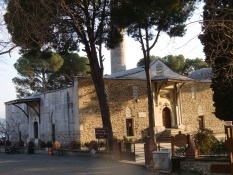 The Çakırağa Konağı stands on one side of a river valley, the lovely Aydınoğlu Mehmet Bey (or Ulu) Cami on the other. The mosque is a relic of the 14th century when, for a brief period, Birgi served as the capital of the Aydınoğlu emirate following the break-up of the Selçuk Sultanate of Rum. But its inland location proved inconvenient and the capital was soon transferred to Ayasuluk (later Selçuk), leaving Birgi to slump back into oblivion.
The Çakırağa Konağı stands on one side of a river valley, the lovely Aydınoğlu Mehmet Bey (or Ulu) Cami on the other. The mosque is a relic of the 14th century when, for a brief period, Birgi served as the capital of the Aydınoğlu emirate following the break-up of the Selçuk Sultanate of Rum. But its inland location proved inconvenient and the capital was soon transferred to Ayasuluk (later Selçuk), leaving Birgi to slump back into oblivion.
Externally the mosque looks quite simple, although the turquoise tiles adorning its minaret hint at something rather special. Closer inspection of the stonework then reveals that the builders had scavenged pieces of the lost Roman settlement of Prygium to incorporate into their work in 1312. Most charmingly, a stone lion with smudgy, worn-down features juts defiantly from the wall.
But it’s the interior of the mosque that really takes the breath away. Steps lead down into a vast five-aisled space, its ceiling supported on rows of reused Roman columns, the pitched roof in the centre a particularly unusual and distinctive touch. The spaciousness of the mosque alone would come as a surprise in such an out-of-the-way place but at once the eye starts to home in on the incredible detail. There is, for example, a stunning mihrab lined with black and blue Selçuk-style tiles and topped with a Koranic inscription, as well as a glorious wooden mimber, parts of which somehow found their way to Scotland only to be returned to Birgi again later.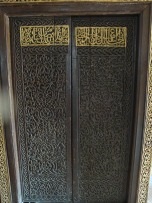
If he’s around the imam will be happy to point out the complex geometric patterns carved into the mimber that appear to emulate the sun, the moon, the stars and the planets. Easier to overlook are the remarkable wooden shutters; a few of these were taken away at a later date to adorn the great Selimiye Cami in Edirne but some of the originals remain, with pearls of wisdom picked out in gold paint along the tops of their frames (“Language is the most beautiful charitable gift. Heaven is a place for the generous”, etc).
Across the road from the mosque stand a ruined hamam and a contemporary medrese (theological school) with a fine arched portico that serves as a handicrafts centre. Right in the middle of the road there is also a türbe (tomb) dating back to the Aydınoğlu period, the rows of tiles set into its small dome mirroring those on the mosque’s minaret.
It’s well worth spending an hour or so just pottering about in Birgi where many lovely old wattle-and-daub houses with patterns incised into their facades are slowly melting back into the landscape. The pine-tree-shaded high street with its immaculate whitewashed, red-tiled cottages is a sobering reminder of what Turkey’s smaller towns could – but rarely do – look like.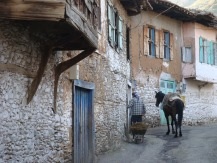
Birgi’s other specific claim to fame is one that will be obscure to most non-Muslim visitors. About one km away from the Ulu Cami, a tree-shaded cemetery and a modern “chapel” are extremely popular with religious tourists who come here to venerate Muhammed ibn Pir Ali, better known as İmam Birgivi. It’s a pleasant short walk out to the site along a road that cuts through the remains of the aqueduct of Pyrgium. Once you’ve recovered from the shock of having to pay to enter the cemetery and from finding stalls there selling the sort of merchandise more suited to a seaside resort, you may find the imam’s burial site rather atmospheric – at least in between coach parties.
Before you leave take a quick look at the fir trees clumped around it – those blessed with a vivid imagination may be able to make out a shape like a pair of axes growing out of the trunk of one of them.
Sleeping
Birgi Çınaraltı (Beneath the Plane Tree) Pansiyon
Dervişağa Konağı. Tel: 0232-531 6060, www.birgi.org
Transport info
From Selçuk catch a bus to Tire, then a second bus to Ödemiş, then a dolmuş to Birgi. The whole journey should take about two hours in each direction.
The rare buses from Ödemiş to Salihli pass through Birgi making it possible to continue on to the ruins at Sardis.
Day trip destinations


